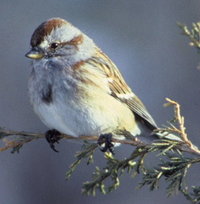Passerine
|
|
| Passerines | ||||||||
|---|---|---|---|---|---|---|---|---|
 American Tree Sparrow (Spizella arborea) | ||||||||
| Scientific classification | ||||||||
| ||||||||
| Families | ||||||||
| Many, see text |
A passerine is a bird of the giant order Passeriformes. More than half of all species of bird are passerines. Sometimes known as perching birds or, less accurately, as songbirds, the passerines are one of the most spectacularly successful vertebrate orders: with around 5,400 species, they are roughly twice as diverse as the largest of the mammal orders, the Rodentia.
The group gets its name from the Latin name for the House Sparrow (Passer domesticus).
| Contents |
Characteristics
Many passerines are songbirds and have complex muscles to control their syrinx; all of them gape in the nest as infants to beg for food.
The order is divided into two suborders, Tyranni, and Passeri (oscines). Oscines have the most control of their syrinx muscles and are true songbirds (though some of them, such as the crow, do not sound like it).
Most passerines are smaller than typical members of other avian orders.
Origin
The evolutionary history of and relationships among the passerine families remained rather mysterious until around the end of the 20th century. Many passerine families were grouped together on the basis of morphological similarities which, it is now believed, are the result of convergent evolution, not a close genetic relationship. For example, the "wrens" of the northern hemisphere, of Australia, and of New Zealand all look very similar and behave in similar ways, and yet belong to three far-flung branches of the passerine family tree: they are as unrelated as it is possible to be while yet remaining Passeriformes.
Much research remains to be done, but a series of biochemical studies are gradually revealing a clearer picture of passerine origins and evolution. It is now thought that the early passerines evolved in Gondwana at about the time that the southern supercontinent was breaking up. This led to the Tyranni and, a little later, to a great radiation of forms in Australia-New Guinea (the Passeri or songbirds). A major branch of the passerine tree, the Passerida (or sparrow-like forms), emerged either as the sister group to another (the Corvida, or crow-like birds), or more likely as a subgroup of the Corvida, and reached the northern hemisphere, where there was a further explosive radiation of new species. Since then, there has been extensive mixing, with northern forms returning to the south, southern forms moving north, and so on.
Taxonomy of passerines
- ORDER PASSERIFORMES
- Suborder Tyranni
- Tyrannidae: tyrant flycatchers
- Pittidae: pittas
- Eurylaimidae: broadbills
- Dendrocolaptidae: woodcreepers
- Furnariidae: ovenbirds
- Thamnophilidae: antbirds
- Formicariidae: antpittas and antthrushes
- Conopophagidae: gnateaters
- Rhinocryptidae: tapaculos
- Cotingidae: cotingas
- Pipridae: manakins
- Philepittidae: asities
- Acanthisittidae: New Zealand wrens
- Suborder Passeri
- Parvorder Corvida
- Menuridae: lyrebirds
- Atrichornithidae: scrub birds
- Climacteridae: Australian treecreepers
- Maluridae: fairy-wrens, emu-wrens and grasswrens
- Meliphagidae: honeyeaters and chats
- Pardalotidae: pardalotes, scrubwrens, thornbills, and gerygones
- Petroicidae: Australian robins
- Orthonychidae: logrunners
- Pomatostomidae: Australasian babblers
- Cinclosomatidae: whipbirds and allies
- Neosittidae: sittellas
- Pachycephalidae: whistlers, shrike-thrushes, pitohuis and allies
- Dicruridae: monarch flycatchers and allies
- Campephagidae: cuckoo shrikes and trillers
- Oriolidae: orioles and Figbird
- Artamidae: wood swallows, butcherbirds, currawongs and Australian Magpie
- Paradisaeidae: birds of paradise
- Corvidae: crows, ravens and jays
- Corcoracidae: White-winged Chough and Apostlebird
- Irenidae: fairy-bluebirds
- Laniidae: shrikes
- Vireonidae: vireos
- Ptilonorhynchidae: bowerbirds
- Turnagridae: Piopio
- Parvorder Passerida
- Alaudidae: larks
- Chloropseidae leafbirds
- Aegithinidae ioras
- Picathartidae: rockfowl
- Bombycillidae: waxwings and allies
- Ptilogonatidae: silky flycatchers
- Cinclidae: dippers
- Motacillidae: wagtails and pipits
- Prunellidae: accentor
- Melanocharitidae: berrypeckers and longbills
- Paramythiidae: tit berrypecker and crested berrypeckers
- Passeridae: true sparrows
- Estrildidae: estrildid finches (waxbills, munias, etc)
- Parulidae: New World warblers
- Thraupidae: tanagers and allies
- Peucedramidae: Olive Warbler
- Fringillidae: true finches
- Drepanididae: Hawaiian honeycreepers
- Emberizidae: buntings and American sparrows
- Nectariniidae: sunbirds
- Dicaeidae: flowerpeckers
- Mimidae: mockingbirds and thrashers
- Sittidae: nuthatches
- Certhiidae: treecreepers
- Troglodytidae: wrens
- Polioptilidae: gnatcatchers
- Paridae: tits, chickadees and titmice
- Aegithalidae: long-tailed tits
- Hirundinidae: swallows and martins
- Regulidae: kinglets
- Pycnonotidae: bulbuls
- Sylviidae: Old World warblers
- Hypocoliidae: Hypocolius
- Cisticolidae: cisticolas and allies
- Zosteropidae: White-eyes
- Timaliidae: babblers
- Muscicapidae: Old World flycatchers and chats
- Turdidae: thrushes and allies
- Sturnidae: starlings
- Parvorder Corvida
- Suborder Tyranni
See also
bg:Врабчоподобни cs:Pěvci da:Spurvefugle de:Sperlingsvögel eo:Paseroformaj birdoj fr:Passereau he:ציפורי שיר ko:연작류 it:Passeriformi ja:スズメ目 li:Zaankveugele lt:virbliniai paukčiai nl:Zangvogels pl:Wróblowe pt:passeriformes sl:Pevci fi:Passeriformes sv:Tättingar zh:雀形目

